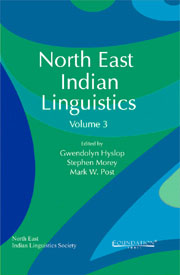Book contents
- Frontmatter
- Contents
- About the Contributors
- Foreword
- A Note from the Editors
- The View from Manipur
- The Sal Group
- 3 Three Meanings of “Language” and “Dialect” in North East India
- 4 An Initial Reconstruction of the Proto-Bodo-Garo Noun Phrase
- 5 Nocte and Jingphaw: Morphological Correspondences
- 6 Tangsa Agreement Markers
- Tibeto-Burman Nominalization
- Tani
- Eastern Indo-Aryan
- Austroasiatic
5 - Nocte and Jingphaw: Morphological Correspondences
from The Sal Group
Published online by Cambridge University Press: 26 October 2011
- Frontmatter
- Contents
- About the Contributors
- Foreword
- A Note from the Editors
- The View from Manipur
- The Sal Group
- 3 Three Meanings of “Language” and “Dialect” in North East India
- 4 An Initial Reconstruction of the Proto-Bodo-Garo Noun Phrase
- 5 Nocte and Jingphaw: Morphological Correspondences
- 6 Tangsa Agreement Markers
- Tibeto-Burman Nominalization
- Tani
- Eastern Indo-Aryan
- Austroasiatic
Summary
Introduction
The genetic relationships among the Tibeto-Burman languages of eastern India and western Burma have always been problematic. While several linguists, including myself, have made stabs at sorting the problem out at higher levels, we can expect that serious progress will start with establishing lower-level groupings, on the order of Burling's (1983) hypothesis of a special relationship among Bodo-Garo, the Konyak Naga languages, and Jinghpaw. This paper discusses data which offer significant support to Burling's “Sal” hypothesis – I will present here what I think is strong comparative evidence for a quite close relationship between Jinghpaw and Nocte, which nails down one side of the triangular Sal grouping.
The Jinghpaw Tense-Aspect-Agreement Complex
Jinghpaw has a very peculiar verbal system, as yet far from thoroughly understood. Along with a large set of grammaticalized verbs (Matisoff 1974; DeLancey, Diehl, et al. 1978), there is a system of morphologically complex final elements, of one or two syllables, which Dai and Diehl (2003) label “Sentence Final Words”, or SFW's. Dai and Diehl's SFW category actually consists of two distinct categories of SFW, which I will label prefinal and final. We will see that the prefinal SFW construction corresponds directly to an almost identical SFW construction in Nocte.
A sentence in Jinghpaw typically ends with some kind of mood particle. In a declarative sentence the default is the final particle ai, which otherwise functions as a nominalizer.
- Type
- Chapter
- Information
- North East Indian Linguistics , pp. 61 - 75Publisher: Foundation BooksPrint publication year: 2011
- 2
- Cited by



